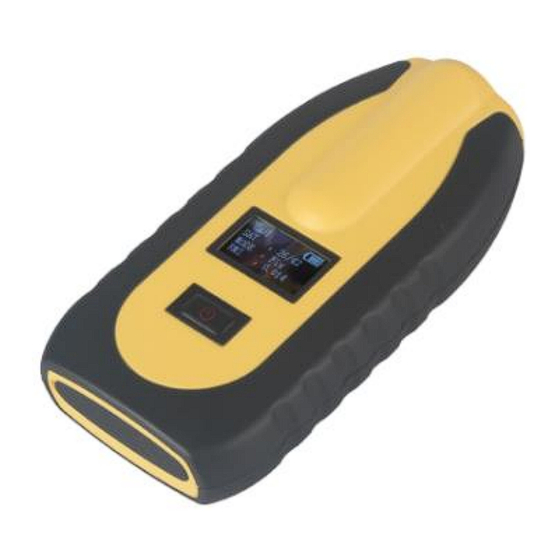
Table of Contents
Advertisement
Quick Links
Advertisement
Table of Contents

Subscribe to Our Youtube Channel
Summary of Contents for SingularXYZ P1
- Page 1 P1 GNSS RECEIVER User Manual V1.1, modified on 2023.2.3...
- Page 2 Website: https://www.singularxyz.com E-mail: singularxyz@singularxyz.com Technical Assistant If you have any questions that can’t be solved in this manual, please contact your local SingularXYZ distribution partner. Alternatively, request technical support from SingularXYZ Intelligent Technology Ltd. Support Email: support@singularxyz.com Support Skype: Support.SingularXYZ Your feedback on this manual will help us improve it with future revisions.
-
Page 3: Table Of Contents
Contents Chapter 1 Introduction About the P1 ............................3 P1 Features ............................3 Packing List ............................3 Chapter 2 Set up the P1 Environmental requirements ......................5 Front Panel ............................5 Lower Housing ............................. 6 Chapter 3 Operations Software Installation .......................... 7 RTK Survey ............................ -
Page 4: About The P1
4G/Bluetooth module, support Ntrip Client mode ⚫ up to 15 hours operation ⚫ 1.3 Packing List Thanks for choosing SingularXYZ P1 GNSS receiver. Please check your package for items listed below. Table 1: Packing list of P1 GNSS receiver Name Quantity Figure... - Page 5 Connector Centering Pole & Bag* 1. Item with * is Optional. 2. You can connect P1 on an optional centering pole for more precise height accuracy by using a connector. Figure 1.1 P1 Connected on Centering Pole P1 GNSS Receiver User Manual...
-
Page 6: Chapter 2 Set Up The P1
This chapter introduces setup of P1 and notice before using it. 2.1 Environmental requirements P1 GNSS receiver is so rugged and designed compactly, but to keep the receiver with a reliable performance and have a lengthy life span, we strongly advise you to use P1 under circumstances below: Operating temperature: -40 °C to + 85 °C (-40 °F to 185 °F) -
Page 7: Lower Housing
2.3 Lower Housing Receiver lower housing contains one SIM card slot, one type C port for charging and data transmission, one pole connector. Figure 2.2 P1 Lower Housing P1 GNSS Receiver User Manual... -
Page 8: Software Installation
Please contact us for download. 3.2 RTK Survey The most frequently used work mode of P1 is RTK based on CORS. First, you need to insert a SIM card to connect to the Internet, then follow the workflow below: 1. - Page 9 Figure 3.1 Connection 2. Rover mode setting The P1 GNSS receiver can receive correction data transmitted from continuously operating reference station via phone Internet. Go to main interface -> Device -> Rover. ⚫ Click the first box shown in Figure 3.2 to set data link as phone Internet.
- Page 10 Figure 3.2 Rover Mode Setting Figure 3.3 Set Rover Mode Succeeded 3. Create or select a project. Main interface -> Project -> Project Manager. P1 GNSS Receiver User Manual...
- Page 11 4. Start surveying. Main Interface->Survey->choose your survey mode and start. Figure 3.4 Surveying P1 GNSS Receiver User Manual...
-
Page 12: Import/Export
Locate your data profile -> select and OK. Figure 3.5 Import Data If you can’t find data format you need, please define it: Main interface -> Project -> Import data -> Data Type -> Choose Import file Format -> New -> define. P1 GNSS Receiver User Manual... -
Page 13: Export
You can export data into multiple formats, like .dat, .txt, etc. Do as shown below: Main interface -> Project -> Export data -> choose Export Path -> File Name -> Choose Export File Format -> Distance Unit -> Export. P1 GNSS Receiver User Manual... - Page 14 Also, you can define export data format: Main interface -> Project -> Export data -> choose Export Path -> File Name -> Choose Export File Format -> New -> define your format. Figure 3.5 Define Data Format P1 GNSS Receiver User Manual...
-
Page 15: Chapter 5 Appendix 5.1 Datasheet
Designed to survive a 1.5 m drop onto concrete Operating temperature -40 °C to + 85 °C (-40 °F to 185 °F) Storage temperature -40 °C to + 85 °C (-40 °F to 185 °F) Humidity 100% non-condensing P1 GNSS Receiver User Manual... - Page 16 APPLICATION Geographical information collection Personnel positioning Vehicle trajectory tracking Inspection and investigation Other high precision applications P1 GNSS Receiver User Manual...




Need help?
Do you have a question about the P1 and is the answer not in the manual?
Questions and answers